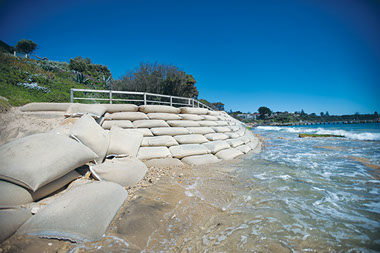A REPORT on the vanishing Portsea Beach has concluded sand erosion is a natural process and there is nothing to be done about it except to shore up the fast-eroding shoreline.
Department of Sustainability and Environment contractors are set to return to the eroded beach to repair the eastern end of the 150-metre sandbag wall – again.
DSE has released the Portsea Prefeasibility Study produced by international consultancy firm Aurecon and a sand monitoring report by GHD.
The report considers erosion management options for the popular family beach and concludes maintenance of the sandbag wall is the best way to protect what is left of the beach.
DSE regional director Rod Warren said other options considered were found to be too risky, too costly or ineffective.
“Since May 2011, DSE has been monitoring between Police Point and Point King to gain a better understanding of sand movement along the shore and offshore Portsea Beach,” he said. The Aurecon report confirmed recent erosion was “consistent with reports of sand movements in the past”.
“Historical information and photos show it has experienced cycles of erosion in the past,” he said.
He comments appeared to dismiss anecdotal evidence from residents who have lived in the area for up to 50 years that sand displacement from Portsea Beach to Shelley Beach in the past three years exceeded anything they had seen before. Many said the changes began after dredging of The Heads during the channel deepening project.
“I know it’s troubling for residents and businesses in Portsea to see the erosion but unfortunately it’s a natural coastal process, happening on beaches around the world,” Mr Warren said.
“Storm surges, waves, tides and wind constantly move and deposit sand along Victoria’s naturally changing coastline.
“This shift of sand occurs at some beaches and as each beach is subject to its individual coastal processes, protection works used at one location may not work at others.”
He cited photos, published in the report, that appeared to show the beach had become “significantly narrower” between 1914 and the 1940s. However, taking into account tidal variation and camera angles, the photos could be thought less conclusive, and none show the beach as severely eroded as it is at present.
DSE would not reveal the cost of the two reports.
The study and sand monitoring report can be viewed on line at www.dse.vic.gov.au/coasts-and-marine/coasts/portsea-protection-works




